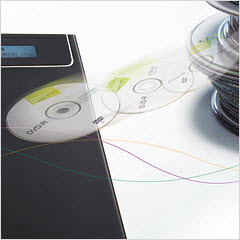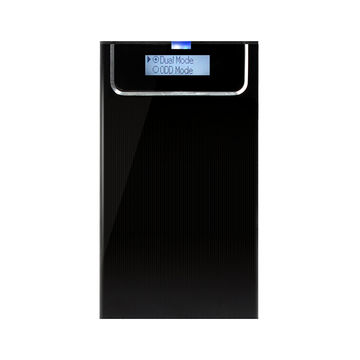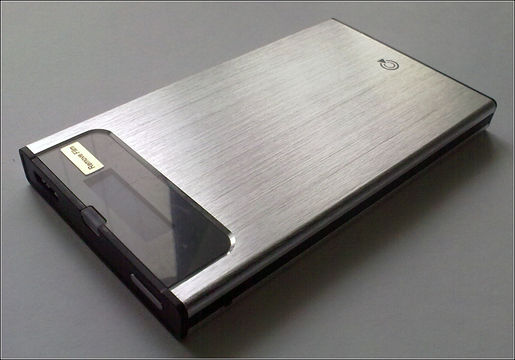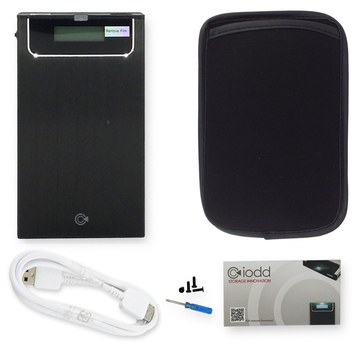Difference between revisions of "IODD-2531"
From iODD
m (→Troubleshooting) |
m (→Troubleshooting) |
||
| Line 177: | Line 177: | ||
''Disc Locked'' | ''Disc Locked'' | ||
<div class="mw-collapsible-content"> | <div class="mw-collapsible-content"> | ||
| − | * Because | + | * Because oOS or a application has locked the ODD drive at any reasons. |
| − | + | ||
</div> </div> | </div> </div> | ||
| Line 184: | Line 183: | ||
''DEFRAG'' | ''DEFRAG'' | ||
<div class="mw-collapsible-content"> | <div class="mw-collapsible-content"> | ||
| − | ISO | + | * ISO file will be permit with max 24 fragment in physical sector address. VHD and RMD must have no fragment. |
| − | + | * To solve this situation, please do [[wken:Disk_Defragmenter_(Windows)|Disk Defragmenter]] for [[wken:Defragmentation| Disk Defragmentation]]. | |
</div> </div> | </div> </div> | ||
| Line 191: | Line 190: | ||
''vDISK Limit'' | ''vDISK Limit'' | ||
<div class="mw-collapsible-content"> | <div class="mw-collapsible-content"> | ||
| − | + | * The max number of Virtual disk drives is 4. | |
| + | * You may select more than 4 Virtual drives. | ||
</div> </div> | </div> </div> | ||
| Line 197: | Line 197: | ||
''Already Hit'' | ''Already Hit'' | ||
<div class="mw-collapsible-content"> | <div class="mw-collapsible-content"> | ||
| − | + | * You may select the file that have been selected yet. | |
</div> </div> | </div> </div> | ||
| Line 203: | Line 203: | ||
''No Use Dynamic'' | ''No Use Dynamic'' | ||
<div class="mw-collapsible-content"> | <div class="mw-collapsible-content"> | ||
| − | + | * The VHD file selected is Dynamic VHD file. fixed VHD is only supported. | |
</div> </div> | </div> </div> | ||
| Line 209: | Line 209: | ||
''No Use Sparse'' | ''No Use Sparse'' | ||
<div class="mw-collapsible-content"> | <div class="mw-collapsible-content"> | ||
| − | + | * The sparse image file is not supported as Virtual Drive. | |
</div> </div> | </div> </div> | ||
Revision as of 14:42, 23 May 2016
Appearance
Functions
- Bootable Virtual CD-ROM, DVD-ROM, Blu-ray Drive
- There is no need to buy DVD-ROM and blank media for OS installation.
- ISO (CD, DVD, Blu-ray) is supported.
- Bootable Virtual USB Drive and Flash Drive.
- iODD supports OS installation and Multi Booting. (and "Windows-To-Go")
- Virtual Disk Drive - can do all functions as USB Flash Drive can do
- VHD and VMDK (Virtual Disk Drive), RMD (Virtual Flash Drive), IMA (Virtual Floppy Disk Drive) are supported.
- Multi LUN
- max 1 optical drive, 1 hard drive, 4 virtual drives are supported at the same time.
- hotkey for safely removal.
- The last physical safeguard. this key provides the safe removal.
- Write Protection
- The last logical safeguard. I keep my drive. Good bye Virus.
- Optional Write Blocker. (Hard wired)
- Real-time AES 256-bit XTS Military Grade Encryption ( iODD-2541 )
- 4-15 Pin digits. 6 digits is enough for protecting your data. (against the developer of iODD-2541)
- All functions work well with Encryption
- Encryption is optional. you can use without encryption.
- Maintain Loading State
- Save and maintain the loading state and menu for next boot.
Menu
- Mode-Select - Define USB devices mode
- Dual Mode - 1 Disk Drive and 1 Optical Disk Drive
- HDD Mode - 1 Disk Drive
- CD Mode - 1 Optical Disk Drive
- Setting
- LCD Bright - Adjust LCD back-light bright
- Idle Bright - Adjust LCD back-light bright in power down mode
- Standby time - Adjust the inactive time before power down mode is active
- Load Default - Restoring all settings to their default values
- Information
- S.M.A.R.T. - Display the following status of the internal Disk Drive
- HDD Temp - Disk Drive Temperature
- HDD Health - Disk Drive Health
- HDD Model - Disk Drive Model
- HDD Serial - Disk Drive Serial
- Firmware Ver - iODD's Firmeare Version
- USB Speed - Currently connected USB Speed
- USB Input Volt - USB BUS voltage (Both Current and Minimum )
- S.M.A.R.T. - Display the following status of the internal Disk Drive
- USB Connect
- Refreah - Reconnect the iODD
- Safe Removal - Stop the spindle motor and power down the Disk Drive
- Advanced
- Umount VHDD - Umount All the Virtual Disk Drives
- Write Protect - Write Protect the internal Disk Drive (Not Virtual Drive)
- Instant Save -
- Force USB 3.0 - Preserve USB 3.0 connection in harsh conditions
Specifications
- External Interface - USB 1.1 / 2.0 / 3.0 (MAX 5G bps)
- Internal Interface - SATA 1.0 / 2.0 / 3.0 (Backward Compatible)
- 2.5" HDD, SSD (9.5mm width) can be installed.
- 3-way jog switch, Back Button, USB 3.0 micro B-Type connector.
- LCD - 128 * 32 dots.
- Material - Aluminum, PC (Plastic).
How to use
- At first please refer to the below Manual.
Initialize
- Two sorts of the firmware are NTFS version and FAT32/exFAT version.
- NTFS firmware version is shipped.
- If you want FAT32 or exFAT Partition, download and update the NTFS Firmware Updater.
- Follow the next steps
- Assemble the HDD or SSD with iODD
- Connect the iODD to PC
- Initialize the drive with MBR
- Format the first partition with NTFS. (if the firmware is FAT then format with FAT32 or exFAT)
- At FAT32 there is 4G byte file size limitation. please expert may use FAT32.
- Make _ISO folder in root folder. (not sensitive)
- Create or Copy *.ISO *.VHD *.RMD *.IMA or sub folder tree to _ISO folder
- Do safely remove the iODD in OS. ( Very Important to NTFS)
- If Power Down mode is active then release and reconnect the USB cable.
- If not then press down the jog button in 3 seconds. and Power Down mode will be on.
- and if Plug Out ... message is out, release and reconnect the USB cable.
- you will see Sequentially iodd 2531 and a file name in root folder.
- If it is not like the above, follow the next
- Release the USB cable.
- Replace the HDD from iODD.
- Initialize the HDD with GPT
- Go to #Initialize(1, the first step) and retry (MBR -> GPT -> MBR).
Using Virtual USB Optical Drive (DVD-ROM or Blu-ray ROM)
- Copy your ISO files to _ISO folder or sub folder.
- Do Safely Remove in your OS. (necessary in NTFS )
- If Power Down mode is not active then press down the jog button in 3 seconds. and Power Down mode will be on.
- If Plug Out ... message is out, release the iODD.
- Connect iODD to your PC and power on the PC.
- (Optional) Make iODD or USB CD-ROM the first in the priority of BOOT sequence in BIOS.
- (Not required if an ISO has been selected) Select an ISO file by Jog dial.
- If Firmware version is 1558 or higher then loading status is automatically saves. if not, you must save it manually by pressing down jog dial in 3 Seconds
- If PC will not find booting device (iODD) then Press Ctrl-Alt-Del to reboot.
Troubleshooting
- Confirm the ISO file whether it is bootable.
- If your PC is old or does not provide multi LUN, please select CD-MODE in Menu.
- In order to confirm whether the ISO file is not good for booting, try to test it with the validated PC.
- Although it is bootable ISO file, it may not boot with USB DVD-ROM. test if it is same result with USB DVD-ROM.
- If It can boot in USB DVD-ROM and can not boot in iODD, please use USB Y-CABLE for adding external power.
- If your laptop has own internal DVD-ROM and iODD does not boot, please disable internal DVD-ROM at booting device list on BIOS settings or remove it.
Using Virtual USB fixed disk drive (Virtual Hard Disk)
- Only fixed VHD file is acceptable. (Not dynamic VHD nor VHDx files)
- Make VHD files directly by VHD Tool++. (VHD Tool++ can make a file without fragment)
- Press Jog dial to select VHD file and iODD will be rebooted with CD-MODE and is recognized as USB disk drive (Virtually).
- If you want DUAL-MODE or to change Write Protect option, rename the VHD file. Refer to VHD Tool++
- Can select max 4 Virtual Drive at the same time ( Successive selection within 3 seconds)
- Create a VHD file with using VHD Tool++ at _ISO folder
- If successful, Do safely remove the iODD in OS. ( Very Important to NTFS)
- If Power Down mode is not active then press down the jog button in 3 seconds. and Power Down mode will be on.
- If Plug Out ... message is out, release the iODD.
- Connect iODD to your PC and power on the PC.
- (Optional) Make iODD or USB CD-ROM the first in the priority of BOOT sequence in BIOS.
- (Not required if a VHD has been selected) Select a VHD file by Jog dial.
- If Firmware version is 1558 or higher then loading status is automatically saves. if not, you must save it manually by pressing down jog dial in 3 Seconds
- If PC will not find booting device (iODD) then Press Ctrl-Alt-Del to reboot.
Using Virtual USB Removable Flash Drive (Virtual USB Flash Drive)
- Almost the same as the above method (Using VHD) only if the file name extension is modified by RMD.
Using Virtual USB Floppy Drive (Virtual FDD)
- This method is not supported on all computers.
- Uncompressed floppy image IMA, IMG, BIF, VFD is supported.
- IMG, BIF, VFD image file extension must be renamed to IMA.
- Almost the same as the above method (Using VHD)
Manual
Troubleshooting
Error Messages
the LCD shows ChkDsk (or gErr) : xxx
- Try one of the following steps in order, until the error is cleared.
- Press the Jog Dial and hold, and connect iODD to PC , and release the Jog Dial after the LCD shows iodd 2531.
- Check Disk for iODD (for Windows)
- Rename _ISO folder to old_ISO. Create new _ISO folder, and copy files to this folder (not move)
- Backup the data of iODD, and Initialize iODD with GPT and successively Initialize iODD with MBR. Format the iODD.
- Update the firmware with latest.
1st partition or unsupported partition
- This error occurs when the Firmware and the First Partition of iODD is not matching.
- Please Check the above #Initialize.
bad or N/S HDD
- Because iODD does not read the internal HDD.
- Please change the HDD or USB cable.
too many files
- iODD can list max 32 files or sub folders in current folders.
- Please use sub folders against max 32 limits.
NO _ISO Folder
- Make a folder named _ISO at root folder.
NO - DISC
- Because there in no files or sub folders in _ISO folder.
Check HDD
- Please Check disk (Check disk).
- Please release the iODD after Safely Remove
Disc Locked
- Because oOS or a application has locked the ODD drive at any reasons.
DEFRAG
- ISO file will be permit with max 24 fragment in physical sector address. VHD and RMD must have no fragment.
- To solve this situation, please do Disk Defragmenter for Disk Defragmentation.
vDISK Limit
- The max number of Virtual disk drives is 4.
- You may select more than 4 Virtual drives.
Already Hit
- You may select the file that have been selected yet.
No Use Dynamic
- The VHD file selected is Dynamic VHD file. fixed VHD is only supported.
No Use Sparse
- The sparse image file is not supported as Virtual Drive.
QNA
화면에 IODD 2531만 출력됩니다.
- 하드웨어 문제인 경우이며 다음중 하나를 실행하세요
- 조그버튼을 누르고 USB 케이블을 연결한다음 3초간 유지합니다.
- USB포트를 PC의 후면에 꽃습니다.(PC의 전면 전압이 낮은경우)
- USB케이블을 교체합니다.(스마트폰에 사용되는 5핀 케이블도 테스트로 사용할 수 있습니다)
- PC를 재부팅 합니다.
- HDD를 교체합니다. ( HDD에서 소리가 나거나 문제가 있는경우).
- 만약 USB허브를 사용하고 있다면,허브를 사용하지 말고 PC에 아이오드를 직접 연결합니다.
- 다른 PC에 연결해 봅니다.
- 위의 처방에도 이 현상이 지속된다면 A/S 접수 해주세요
가상 드라이브 (VHD, RMD, IMA)를 마운트 하면 자동으로 CD-MODE 로 되고 DUAL-MODE 로 변경하면 쓰기 금지가 됩니다.
- 파일명을 변경하면 됩니다. VHD Tool++ 참조 바랍니다.
가상 드라이브 (VHD, RMD, IMA) 마운트를 해제하고 싶습니다.
- 다음중 하나를 실행하세요
- USB 커넥터 옆의 기능 버튼을 길게 누른다 ( 펌웨어 1555 이상 )
- Menu->Advanced->Umount VHDD
펌웨어 업데이트가 자꾸 실패합니다.
업데이트 방법 을 확인하세요
펌웨어
업데이트 방법
최신
- 2016. 4. 23 - NTFS 버전 1558, FAT32/exFAT 버전 1558
- Menu -> Advanced->Instant Save 기능추가
- 체크 되어있으면 ISO 파일 선택시 로딩정보 바로 저장
이전
- 2016. 3. 28 - NTFS 버전 1555, FAT32/exFAT 버전 1555
- VHD, RMD 모드에서 Rufus 프로그램 지원
- 2014. 6. 2 - NTFS 버전 1288, FAT32/exFAT 버전 1288
- 장기 안정 펌웨어



